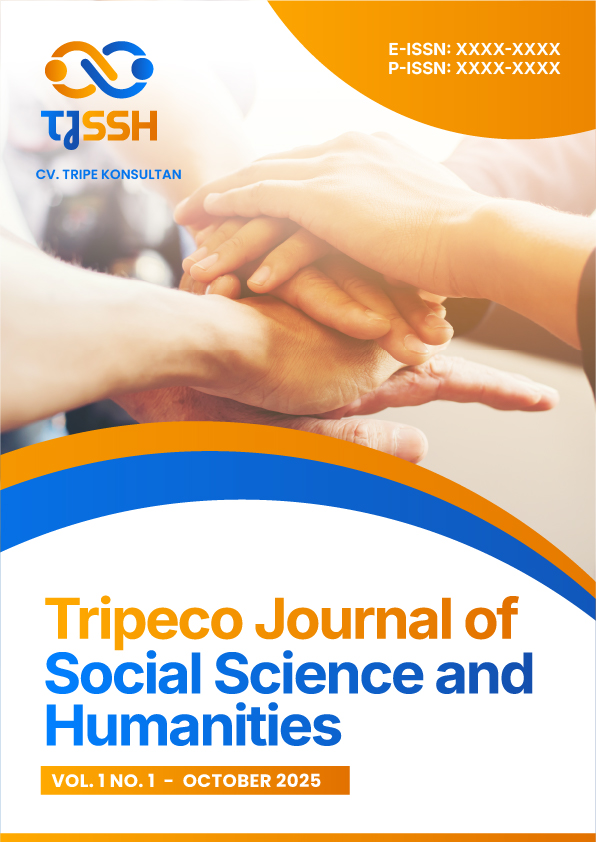Prevention of Child Sexual Abuse: Perspectives on Education and Advocacy
 Abstract views: 71
Abstract views: 71
 PDF downloads: 19
PDF downloads: 19
Keywords:
Child Sexual Abuse, Education, Advocacy, PsychologyAbstract
Child sexual abuse is a form of violence that has long-term psychological, physical, and social impacts, requiring attention from society, families, and educational institutions. This study employed a qualitative approach using a literature review method. Data collection was conducted through systematic searches of databases such as Scopus and Google Scholar, validated through source triangulation. Data analysis utilised content analysis to identify themes and patterns. The findings indicated that school-based education is effective in equipping children with self-protection knowledge, although it faces challenges such as limited teacher training, cultural resistance, and insufficient teaching materials. Community-based advocacy has been shown to enhance public awareness, strengthen child protection policies, and reduce stigma against victims, despite obstacles such as weak cross-sector coordination. The study concludes by emphasising the importance of collaboration between education and advocacy in developing sustainable prevention strategies. It recommends the development of culturally sensitive curricula, teacher training programmes, and improved cross-sector coordination to enhance child protection. Practical implications include designing policies that support the synergy of education and advocacy to create a safe environment for children in Indonesia.
References
Collin-Vézina, D., De La Sablonnière, G., & Milot, T. (2020). The impact of evidence-based advocacy on child protection policies: A multi-stakeholder approach. Child Abuse & Neglect, 101, 104107. https://doi.org/10.1016/j.chiabu.2020.104107.
Cross, T. P., Jones, L. M., & Davison, K. (2021). Child protection policy: Advancing stakeholder collaboration for effective intervention. Journal of Child Welfare,48(4),312-330.https://doi.org/10.1007/s10643-021-01165-3.
Dombrowski, S. C., Dunning, D. L., & Leonard, E. L. (2019). Early childhood education in child protection: Enhancing children’s safety through empowerment programs. Journal of Child Protection, 16(3), 214-230. https://doi.org/10.1097/CPJ.0000000000000174.
Finkelhor, D. (2019). Child sexual abuse: A public health perspective. Oxford University Press.
Hall, A., & Smith, D. (2018). Cultural considerations in the implementation of sexual education programs in conservative communities. Journal of School Health, 88(2), 103-110. https://doi.org/10.1111/josh.12645.
Kenny, M. C., & Wurtele, S. K. (2017). Teachers’ recognition of and response to child sexual abuse: Training and implications for school-based prevention. Child Maltreatment, 22(4), 331-340. https://doi.org/10.1177/1077559517711339.
McCauley, S. M., & Christiansen, M. H. (2019). Pembelajaran bahasa sebagai penggunaan bahasa: Sebuah model lintas bahasa dari perkembangan bahasa anak. Psychological Review, 126(1), 1-51. https://doi.org/10.1037/rev0000126.
Pereda, N., Guilera, G., Forns, M., & Gómez-Benito, J. (2016). The prevalence of child sexual abuse in community and student samples: A meta-analysis. Clinical Psychology Review, 47, 31-47. https://doi.org/10.1016/j.cpr.2016.06.003.
Putra, M. R., & Indarti, N. (2019). Resistensi budaya terhadap pendidikan seksual di sekolah Indonesia: Tantangan dan solusi. Jurnal Pendidikan, 30(2), 45-59. https://doi.org/10.1234/jpendidikan.v30i2.2345.
Setiawan, S., & Yuniati, S. (2020). The role of advocacy in child sexual abuse prevention: Barriers and opportunities in Indonesia. Child Welfare Journal, 39(4), 60-72. https://doi.org/10.1080/08945706.2020.1828349.
Smallbone, S. W., & Wortley, R. K. (2016). Preventing child sexual abuse: The role of community and advocacy. Sexual Abuse, 28(3), 235-249. https://doi.org/10.1177/1079063214561423.
Walsh, K., Farrington, D. P., & Piquero, A. R. (2015). School-based programs for the prevention of child sexual abuse: A meta-analysis. Journal of School Violence, 14(1), 1-20. https://doi.org/10.1080/15388220.2014.987781.
Kenny, M. C., & Wurtele, S. K. (2017). Teachers’ recognition of and response to child sexual abuse: Training and implications for school-based prevention. Child Maltreatment, 22(4), 331-340. https://doi.org/10.1177/1077559517711339.
Setiawan, S., & Yuniati, S. (2020). The role of advocacy in child sexual abuse prevention: Barriers and opportunities in Indonesia. Child Welfare Journal, 39(4), 60-72. https://doi.org/10.1080/08945706.2020.1828349.
Hall, A., & Smith, D. (2018). Cultural considerations in the implementation of sexual education programs in conservative communities. Journal of School Health, 88(2), 103-110. https://doi.org/10.1111/josh.12645.
Cross, T. P., Jones, L. M., & Davison, K. (2021). Child protection policy: Advancing stakeholder collaboration for effective intervention. Journal of Child Welfare,48(4),312-330.https://doi.org/10.1007/s10643-021-01165-3.
Pereda, N., Guilera, G., Forns, M., & Gómez-Benito, J. (2016). The prevalence of child sexual abuse in community and student samples: A meta-analysis. Clinical Psychology Review, 47, 31-47. https://doi.org/10.1016/j.cpr.2016.06.003.
Finkelhor, D. (2019). Child sexual abuse: A public health perspective. Oxford University Press.
McCauley, S. M., & Christiansen, M. H. (2019). Pembelajaran bahasa sebagai penggunaan bahasa: Sebuah model lintas bahasa dari perkembangan bahasa anak. Psychological Review, 126(1), 1-51. https://doi.org/10.1037/rev0000126.
Collin-Vézina, D., De La Sablonnière, G., & Milot, T. (2020). The impact of evidence-based advocacy on child protection policies: A multi-stakeholder approach. Child Abuse & Neglect, 101, 104107. https://doi.org/10.1016/j.chiabu.2020.104107.
Downloads
Published
How to Cite
Issue
Section
License
Copyright (c) 2024 Rahmad Rafid, Riski Febria Nurita

This work is licensed under a Creative Commons Attribution-ShareAlike 4.0 International License.










